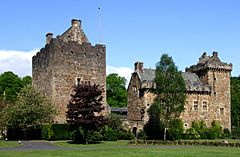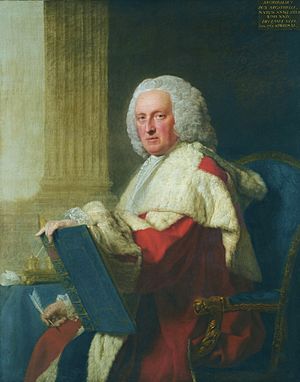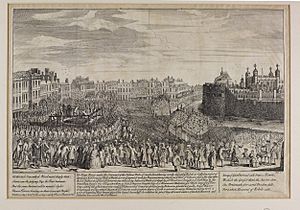William Boyd, 4th Earl of Kilmarnock facts for kids
Quick facts for kids
William Boyd, 4th Earl of Kilmarnock
|
|
|---|---|

William Boyd, 4th Earl of Kilmarnock ca 1746
|
|
| Born | William Boyd 12 May 1705 Dean Castle, Kilmarnock |
| Died | 18 August 1746 (aged 41) Tower Hill |
| Cause of death | Executed for treason |
| Resting place | St Peter ad Vincula, Tower of London |
| Title | Earl of Kilmarnock |
| Tenure | 1717 to 1746 |
| Nationality | Scottish |
| Residence | Dean Castle Callendar House |
| Locality | East Ayrshire |
| Wars and battles | 1745 Jacobite Rising Falkirk Culloden |
| Offices | Grand Master, Masonic Grand Lodge of Scotland 1742-1743 |
| Spouse(s) | Anne Livingstone (1709–1747) |
| Issue | James (1726–1778), Charles (1728–1782), William (1724–1780) |
| Parents | William Boyd, 3rd Earl of Kilmarnock Eupheme Ross |
|
|
|
William Boyd, 4th Earl of Kilmarnock (born May 12, 1705 – died August 18, 1746) was a Scottish nobleman. He joined a major rebellion in Scotland called the 1745 Jacobite Rising. He was captured after the important Battle of Culloden. Sadly, he was later put to death for going against the government.
His family usually supported the government. William Boyd had not been involved with the Jacobites before. He later said he joined because he was very poor. He didn't care which side won, he just needed money to live.
After his death, his noble title was taken away. His family's lands, which had many debts, were also taken by the government. However, these lands were later given back to his oldest son, James. James actually fought on the government's side during the rebellion.
Contents
Early Life and Family of William Boyd

William Boyd was born in 1705. He was the only son of William Boyd, the 3rd Earl of Kilmarnock (1683–1717), and Eupheme Ross (1684–1729). His father supported the government during an earlier rebellion in 1715. However, his father was deep in debt when he passed away in 1717.
William went to the University of Glasgow. People said he didn't like studying hard. Instead, he enjoyed activities like riding horses, fencing, dancing, and music. He was known as a polite gentleman.
Marriage and Financial Challenges
In 1724, William married Lady Anne Livingston. She was the only daughter of James Livingston, the 5th Earl of Linlithgow. Her father had lost his noble title and lands because he was a Jacobite in the 1715 rebellion.
Even though Anne's family had lost their estates, she was still considered wealthy. This was because the government had trouble selling off the lands taken from Jacobites. They often made deals with the original owners. Anne became financially secure through one of these deals.
Anne married William even though her family didn't want her to. Money problems and William's lifestyle were always an issue for them. They lived together "civilly," which means politely, but perhaps not happily.
Homes of the Earl and Countess
The Earl and Countess lived at Dean Castle in Kilmarnock, Scotland. But in 1735, a fire badly damaged the castle. They couldn't afford to fix it. So, they moved to Anne's family home, Callendar House, near Falkirk. This house stayed in her family until 1783.
William's son James sold Dean Castle in 1746. The castle remained a ruin until it was fixed up in the early 1900s.
William Boyd's Public Role
William Boyd's noble title gave him a place in the House of Lords. This is part of the British Parliament. He voted as he was told by important political figures like Archibald Campbell, 3rd Duke of Argyll and Robert Walpole. He received a small payment for this. However, this payment stopped when Walpole lost power in 1742.
William was also the Grand Master for the Scottish Freemasons from 1742 to 1743. This was an important leadership role in a well-known social group.
Joining the Jacobite Rebellion

William first met Prince Charles, the leader of the Jacobite rebellion, at Callendar House on September 14. His decision to join the Jacobite army surprised many people. Some thought his wife's family might have pressured him.
However, he later told the Duke of Argyll that he joined because he was "starving." He meant he was very poor and needed money. He said he would have joined any side that offered him a way to earn a living.
On October 18, William was given a leadership role in a group called "Kilmarnock's Horse." This group was mostly made up of volunteers. He was one of the few noblemen from the Lowlands of Scotland to join the rebellion. He quickly became important to Prince Charles. This was partly because he wasn't connected to the other Scottish Jacobite leaders, like Lord George Murray.
There were often disagreements between Prince Charles and his advisors and the Scottish leaders. William Boyd was one of the few Scots who always supported Prince Charles.
Role in Battles
When the main Jacobite army went into England on November 8, William's cavalry unit was combined with another. They had about 130 men in total. Their main job was to scout ahead and gather information. They were the last to leave the city of Carlisle on December 21 before returning to Scotland.
In early January, the Jacobites tried to capture Stirling Castle. The government tried to help the castle, which led to the Battle of Falkirk on January 17. This battle happened near Callendar House, where William's wife, Lady Anne, was staying. She was even hosting the government general, Hawley, at her house. Some stories say she kept him at dinner to distract him from the battle.
The Battle of Falkirk was fought in the dark during a bad storm. It was very confusing. William's cavalry wasn't directly involved. But his knowledge of the local area helped find the retreating government forces afterward.
Falkirk was a victory for the Jacobites. However, poor leadership meant they couldn't win completely. Many Highland soldiers went home after the battle. When the government army, led by Cumberland, advanced again, Prince Charles was told his army was not ready to fight. On February 1, 1746, the Jacobites stopped trying to capture Stirling and moved to Inverness.
William's troops helped cover the retreat. Their horses were in such bad shape that the men became foot soldiers. They were then called "Foot Guards." For the next two months, they stayed in Elgin. They were part of a force guarding the River Spey. The Jacobites were low on money and had to take supplies from local shops.
In April, the Jacobite leaders decided they needed a big victory. This led to the Battle of Culloden. The Jacobites were badly defeated in less than an hour. William's son, James, was fighting on the government side. William was with the Jacobite reserve troops and saw little action.
Trial and Execution

William Boyd was put on trial in London on July 29. He, Lord Balmerino, and the Earl of Cromartie were found guilty of going against the government. They were sentenced to death. Their sentence was changed to beheading instead of a more brutal execution.
People expected one of them to be pardoned, or forgiven. William's fellow Freemason, the Duke of Hamilton, tried to help him. But the pardon went to the Earl of Cromartie. Cromartie's wife, who was pregnant, asked the Princess of Wales for help. Some believed that the Duke of Hamilton's efforts for William actually made his execution happen faster.
The executions took place at Tower Hill on August 18. William Boyd was executed first. Before his death, Lord Balmerino arranged to speak with him. They talked about a supposed "no quarter" order. This order, which may not have even existed, was said to have been given by Jacobite leaders before Culloden. It was used to justify the harsh actions of the government.
Balmerino made sure William confirmed that if such an order existed, the blame was on Lord George Murray, not Prince Charles. This version was later put into the official trial records. Even at the end, the disagreements among the Jacobites continued.
William Boyd followed the custom of prisoners facing death. He expressed sorrow and accepted that his sentence was fair. He confirmed that King George II was the rightful ruler. He wrote letters to his sons and wife and asked for help with his debts. After his execution, he was buried in St Peter ad Vincula, a church near the Tower of London.
Lady Anne, his wife, died a year later in September 1747. She is remembered with a mural in St Marnock Square in Kilmarnock.
Images for kids
-
Kilmarnock's restored family home, Dean Castle; gutted by fire in 1735 and left derelict until 1908
-
Kilmarnock's political patron, the 3rd Duke of Argyll
-
Execution of the Earl of Kilmarnock and Lord Balmerino
| Masonic offices | ||
|---|---|---|
| Preceded by The Earl of Leven |
Grand Master of the Grand Lodge of Scotland 1742–1743 |
Succeeded by The Earl of Wemyss |
| Peerage of Scotland | ||
| Preceded by William Boyd |
Earl of Kilmarnock 1717–1746 |
Forfeit |





